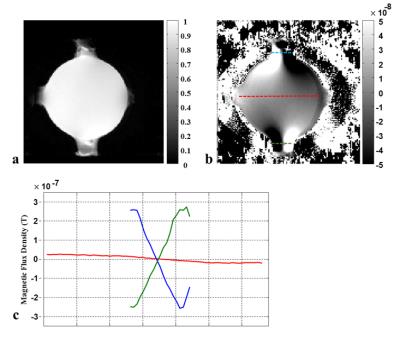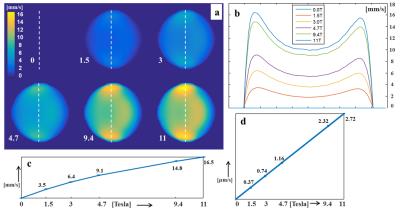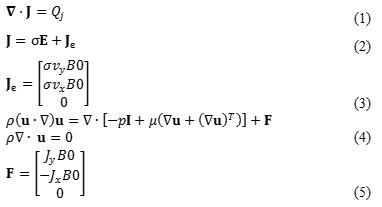1005
Analysis of magnetohydrodynamic effects in current injection induced magnetic flux density images at very high magnetic fields1Centre for Pre-clinical Imaging, Department of Cellular and Molecular Physiology, University of Liverpool, Liverpool, United Kingdom, 2School of Biological and Health Systems Engineering, Arizona State University, Tempe, AZ, United States
Synopsis
Magnetic resonance imaging based electrical conductivity imaging of biological tissues could be highly challenging at magnetic fields of the order of 18.8T. We could see significant magnetohydrodynamic (MHD) effects in low viscosity materials at such fields. In this study, we investigated these effects using saline and agarose phantoms and explained the MHD mechanism using a fluid flow model coupled with electromagnetic field equations. Experimental and simulation results showed a correlation between the higher magnetic field and velocity. This relation changed from exponential to linear as the viscosity of material increased. The velocity was negligible for highly viscous materials such as agarose.
Introduction
Injection current based electrical conductivity imaging of biological tissues has been widely investigated at clinical magnetic fields1. Saline and agarose phantoms have been successfully used at lower magnetic fields to develop novel methods for technical advancement2. However, imaging at very high magnetic fields offer unforeseen challenges. The induced magnetic field due to current injection may couple with the external main magnetic field to produce magnetohydrodynamic (MHD) effects and consequently motion in the phantom material3. In this study, we aimed to investigate this phenomenon and explain its mechanism using multi-physics simulations solving the electromagnetic field equations coupled with fluid flow.Methods
We developed two phantoms of 1 S/m conductivity with different viscosities, using either saline or agarose. We injected 200 $$$\mu$$$A current through carbon electrodes attached to phantom surface. A spin echo ICNE pulse sequence was used to acquire complex k-space data using a 18.8T vertical bore Varian MRI scanner2. Our imaging parameters were: TR/TE=1000/20ms, imaging matrix=128×128, slice thickness=1mm, in-plane resolution=12×12mm2, number of averages=2. We collected data for two polarities of current injection with a total data acquisition time of 8min32s and calculated the z-component of the induced magnetic flux density (Bz)1.
We developed a multi-physics model using a commercial software COMSOL (Comsol Inc, Burlington, MA, USA) by coupling the laminar flow equations with the electromagnetic field equations. The equations (1)-(5) in figure 4 explain the governing physics behind our MHD model. We assumed a domain $$$\chi$$$ having an electrical conductivity $$$\sigma$$$. We injected imaging current through surface electrodes, producing a current density J1=$$$\sigma$$$E, an electric field E and electric potential u in $$$\chi$$$. The J1 induced a magnetic flux density which interacted with the main magnetic field B0 of the MR scanner and produced a volume force F. This force created motion in the domain $$$\chi$$$ whose spatially varying velocity vx,y depended on the viscosity in $$$\chi$$$. Depending on the strength of B0 and the amplitude of vx,y , a secondary current density Je was produced which created a secondary magnetic field.
In our model, we assumed the normal current density and ground to be the two electrical boundary conditions on two ports, and insulation elsewhere. An open boundary was specified at the top surface of $$$\chi$$$. The various boundary settings were: normal current density = 63.66 A/m2, normal stress f0 = 0 N/m2, density of saline solution = 1000 kg/m3 and dynamic viscosity = 1 mPa s. By default, the laminar flow physics assumed a ‘Wall’ boundary condition in COMSOL. We specified ‘No Slip’ boundary conditions on all external boundaries, except at the open boundary of the saline or agar medium in $$$\chi$$$.
Results and Discussion
Figure 1 shows the experimental results of measuring the magnetic flux density from complex k-space MR images for saline phantom. The images in a, b are the MR magnitude and Bz respectively. The profiles in figure c compare the Bz at three different locations labelled in b. The images in figure 2 show the corresponding results for agarose phantom.
Comparing the Bz profiles in figure 1c and 2c, we note that the slopes of the saline phantom Bz distribution are opposite each other at the current injection and ground ports. This implies that there was no net current flow across the electrodes. Instead, the induced magnetic field circulated locally around each port. This phenomenon was not observed in agarose phantoms in figure 2.
Figure 3 shows the MHD simulation results for the magnitude of velocity generated as a function of the external magnetic fields B0 = [0,1.5,3,4.7,9.4,11] Tesla for saline phantom (a-c). The maximum value of velocity (vmax) appeared closer to the ports of current injection and ground which indicates a strong motion around the ports. The vmax at 3T was 6.4 mm/s. We estimated the vmax to be 22.6 mm/s at 18.8T based on the exponential relation between B0 and velocity as can be seen in figure 3c. The exponential relation changed to linear relation in highly viscous materials like agarose with viscosity=10 Pa s (figure 3d). Using this relation, we estimated the vmax to be 4.7 $$$\mu$$$m/s at 18.8T.
Conclusion
We can conclude that at higher main magnetic fields of the order of 18.8T, there is a significant amount of motion in fluids when medium viscosity is close to water. Since these velocity values should vary with the size of imaged object, it would be smaller for larger imaging objects used at lower magnetic fields. Future studies should calculate the additional magnetic flux densities (Bz) caused by time-varying injection current pulses at high fields.Acknowledgements
No acknowledgement found.References
1. Woo E J and Seo JK. Magnetic resonance electrical impedance tomography (MREIT) for high-resolution conductivity imaging. Physiol Meas. 2008;29(10):R1-26.
2. Minhas A S, Jeong W C, Kim Y T, et.al. Experimental performance evaluation of multi-echo ICNE pulse sequence in magnetic resonance electrical impedance tomography. Magn Reson Med. 2011;66(4):957-65.
3. Davidson P A. An Introduction to Magnetohydrodynamics. Cambridge University Press; 2001.
Figures



